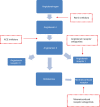Proteinuria and its relation to cardiovascular disease
- PMID: 24379690
- PMCID: PMC3873205
- DOI: 10.2147/IJNRD.S40522
Proteinuria and its relation to cardiovascular disease
Abstract
Chronic kidney disease (CKD) and its associated morbidity pose a worldwide health problem. As well as risk of endstage renal disease requiring renal replacement therapy, cardiovascular disease is the leading cause of premature death among the CKD population. Proteinuria is a marker of renal injury that can often be detected earlier than any tangible decline in glomerular filtration rate. As well as being a risk marker for decline in renal function, proteinuria is now widely accepted as an independent risk factor for cardiovascular morbidity and mortality. This review will address the prognostic implications of proteinuria in the general population as well as other specific disease states including diabetes, hypertension and heart failure. A variety of pathophysiological mechanisms that may underlie the relationship between renal and cardiovascular disease have been proposed, including insulin resistance, inflammation, and endothelial dysfunction. As proteinuria has evolved into a therapeutic target for cardiovascular risk reduction in the clinical setting we will also review therapeutic strategies that should be considered for patients with persistent proteinuria.
Keywords: albuminuria; cardiovascular risk; microalbuminuria; proteinuria.
Figures
Similar articles
-
Subclinical Kidney Damage in Hypertensive Patients: A Renal Window Opened on the Cardiovascular System. Focus on Microalbuminuria.Adv Exp Med Biol. 2017;956:279-306. doi: 10.1007/5584_2016_85. Adv Exp Med Biol. 2017. PMID: 27873229 Review.
-
Time to abandon microalbuminuria?Kidney Int. 2006 Oct;70(7):1214-22. doi: 10.1038/sj.ki.5001729. Epub 2006 Jul 26. Kidney Int. 2006. PMID: 16871239 Review.
-
The link between microalbuminuria, endothelial dysfunction and cardiovascular disease in diabetes.Cardiovasc J S Afr. 2002 Jul-Aug;13(4):194-9. Cardiovasc J S Afr. 2002. PMID: 12389063 Review.
-
Cardiovascular implications of proteinuria: an indicator of chronic kidney disease.Nat Rev Cardiol. 2009 Apr;6(4):301-11. doi: 10.1038/nrcardio.2009.11. Nat Rev Cardiol. 2009. PMID: 19352334 Review.
-
Risk of Progression of Nonalbuminuric CKD to End-Stage Kidney Disease in People With Diabetes: The CRIC (Chronic Renal Insufficiency Cohort) Study.Am J Kidney Dis. 2018 Nov;72(5):653-661. doi: 10.1053/j.ajkd.2018.02.364. Epub 2018 May 18. Am J Kidney Dis. 2018. PMID: 29784612
Cited by
-
Intravenous administration of iPS-MSCSPIONs mobilized into CKD parenchyma and effectively preserved residual renal function in CKD rat.J Cell Mol Med. 2020 Mar;24(6):3593-3610. doi: 10.1111/jcmm.15050. Epub 2020 Feb 15. J Cell Mol Med. 2020. PMID: 32061051 Free PMC article.
-
Laboratory markers of ventricular arrhythmia risk in renal failure.Biomed Res Int. 2014;2014:509204. doi: 10.1155/2014/509204. Epub 2014 May 26. Biomed Res Int. 2014. PMID: 24982887 Free PMC article. Review.
-
Relationship Between Sarcopenia and Albuminuria: The 2011 Korea National Health and Nutrition Examination Survey.Medicine (Baltimore). 2016 Jan;95(3):e2500. doi: 10.1097/MD.0000000000002500. Medicine (Baltimore). 2016. PMID: 26817888 Free PMC article.
-
Prognostic impact of baseline urinary albumin excretion rate in patients with resistant hypertension: a prospective cohort study.J Hum Hypertens. 2018 Feb;32(2):139-149. doi: 10.1038/s41371-017-0013-2. Epub 2017 Dec 11. J Hum Hypertens. 2018. PMID: 29230004
-
Preoperative proteinuria is independently associated with mortality after fenestrated endovascular aneurysm repair.J Vasc Surg. 2024 Jun;79(6):1360-1368.e3. doi: 10.1016/j.jvs.2024.01.013. Epub 2024 Jan 12. J Vasc Surg. 2024. PMID: 38219966 Free PMC article.
References
-
- Sarnak MJ, Levey AS, Schoolwerth AC, et al. American Heart Association Councils on Kidney in Cardiovascular Disease, High Blood Pressure Research, Clinical Cardiology, and Epidemiology and Prevention Kidney disease as a risk factor for development of cardiovascular disease: a statement from the American Heart Association Councils on Kidney in Cardiovascular Disease, High Blood Pressure Research, Clinical Cardiology, and Epidemiology and Prevention. Circulation. 2003;108(17):2154–2169. - PubMed
-
- Agrawal V, Marinescu V, Agarwal M, McCullough PA. Cardiovascular implications of proteinuria: an indicator of chronic kidney disease. Nat Rev Cardiol. 2009;6(4):301–311. - PubMed
-
- Wagner DK, Harris T, Madans JH. Proteinuria as a biomarker: risk of subsequent morbidity and mortality. Environ Res. 1994;66(2):160–172. - PubMed
-
- Garg AX, Kiberd BA, Clark WF, Haynes RB, Clase CM. Albuminuria and renal insufficiency prevalence guides population screening: results from the NHANES III. Kidney Int. 2002;61(6):2165–2175. - PubMed
-
- Culleton BF, Larson MG, Parfrey PS, Kannel WB, Levy D. Proteinuria as a risk factor for cardiovascular disease and mortality in older people: a prospective study. Am J Med. 2000;109(1):1–8. - PubMed
Publication types
LinkOut - more resources
Full Text Sources
Other Literature Sources
Research Materials


